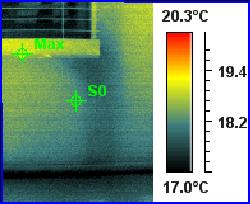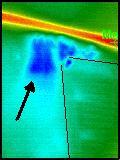Is your household damp in areas?
Dampness can cause serious mould build up on walls and furniture … and also cause your window frames to rot. A damp cold home will encourage the growth of mould and mites, and mites thrive on moulds… increasing the risk of allergic reactions and respiratory illnesses to the home occupants.
Dampness can be caused by condensation. The information below explains how condensation forms and how you can reduce the potential of dampness and mould growth in the home.
Step 1 – Condensation
If you have a condensation problem in certain areas of your home, you will need to take the appropriate steps to fix the problem as soon as possible, but in the meantime, there are some precautionary measures you can take right away.
Wipe down the windows and sills wherever the condensation is forming every time you see it appear. This process is slightly tedious but it’s only a short term measure until the overall solution is complete.
Condensation channels and sponge strips can be purchased at just about all DIY shops, such as Bunnings. They are fitted to windows to collect the condensation and thus help prevent window frames from rotting and avoid damp forming under sills. Care must be taken to fit these devices properly.
First steps to prevent mould
First treat the mould already in your home. If you deal with the basic problem right away, the mould won’t resurface for some time. If aren’t sure where the damp areas are (usually you won’t see them until it’s too late), then NZ Leak & Heat Loss Detection Ltd can quickly identify these areas with a thermal imaging camera for you.
To eradicate and remove mould, wipe down walls and window frames with a fungicidal wash or similar. Follow the manufacturer’s instructions and you should get the result you’re looking for. Dry-clean mildewed clothes, and shampoo your carpets. Carpet in the home can be a silent killer! Disturbing mould by brushing or vacuum cleaning can increase the risk of respiratory problems, so get those carpets cleaned asap!
Use a quality fungicidal paint to help prevent mould in the future after you’ve cleaned the wall thoroughly. This type of paint is usually not effective if applied over the top of existing paints or wallpaper.
Eliminating dampness in the home altogether is the only long term solution. Our company specialises in detecting mould using infrared equipment… so finding the mould has never been so easy.
Is it actually condensation that’s causing the damp?
Condensation is not the only catalyst causing dampness. It can also come from:
• Leaking pipes, wastes or overflows.
• Rain seeping through the roof where a tile or slate is missing, spilling from a blocked gutter, penetrating around window frames, or leaking through a cracked pipe.
• Rising damp due to a defective damp-course or because there is no damp-course.
These causes of dampness in the home often leave a ‘tidemark’ and you should have the necessary repairs carried out to remove the source of damp. We can detect moisture that has penetrated from the exterior of your home by scanning the interior walls. All damp areas are also confirmed by a secondary check with a moisture meter.
If your home is newly built it may be damp because the water used during its construction (e.g. in plaster) is still drying out. Some people perceive that if a home is brand new that it won’t leak. In most cases they won’t (not visibly anyway), but do check that all showers have been sealed before you begin to use them. Builders and contractors can miss these details from time to time… so just cast your eye around any wet areas to confirm they’re sealed so no water will penetrate through.
If your home is damp for any of these reasons, it could take weeks of heating and ventilating to dry out. Hiring a dehumidifier it always recommended when the source of the leak is determined and fixed. We can track a leak to its source using our thermal imaging process.
If you don’t believe the dampness is stemming from any of these above causes, then condensation is the likely cause.
So what is condensation and how does it form?
There is always some degree of moisture in the air around us, but it’s simply to visible to the human eye. If the air gets colder it cannot contain all the moisture particles, and as a result tiny droplets of water will appear. This is condensation, and we that’s when we can see it. You may notice it when when the mirror mists over when you take a shower.
Condensation occurs mainly during cold weather (like a typical NZ winter), whether it is raining or dry. It does not leave a ‘tidemark’. It appears in places where there is little movement of air. Look for it in corners, on or near windows, in or behind wardrobes and cupboards.
Here’s how to avoid condensation.
These 4 steps below will help you reduce the condensation build up in your household.
1. Produce less moisture
Some of our routine day-to-day activities produce moisture very quickly. Such as…
Cooking: To reduce the amount of moisture escaping the kitchen, cover pans and do not leave kettles boiling after they hit the boiling point. Use the kitchen fan always.
Portable flueless bottled-gas heaters: These type of heaters put moisture directly into the air. Did you know that one gallon of gas or paraffin produces approx 4 liters of water? If you have a problem with condensation, try to find alternative means of heating, or vent the heating you do have.
Washing clothes: If you use a clothes dryer, make sure you vent it to the outside (unless it is the self-condensing type). The other option is to hang the clothes in a room with a fan blowing and window open. Be sure to shut the door to avoid the moist air spreading through the rest of the home.
2. Ventilate to remove the moisture
You can ventilate your home without needing air draughts.
Some kind of ventilation is needed to get rid of moisture that is consistently being produced, including that from people’s breath. Keep a small window slightly ajar or a trickle ventilator open at all times if possible, and especially when humans are in the room.
Larger amounts of ventilation are required in the kitchen and bathroom when cooking, washing up, bathing and drying clothes etc. This simply means opening the windows wider. A humidistat-controlled electric fan is always best… this type of fan will come on automatically when the air becomes humid).
Close the kitchen and bathroom doors when these rooms are in use even if your kitchen or bathroom has an extractor fan. It will help to draught proof these doors. Doing this will help stop the moisture flowing into other household rooms, especially the bedrooms, which are more often than not colder and more likely to form condensation… resulting in mould spore growth on the walls, sheets and pillows etc.
Allow space for the air to circulate in and around your furniture. Open doors to ventilate cupboards and wardrobes from time to time. Leave space between the backs of wardrobes and the wall (this is a common place for mould growth). Where possible, position wardrobes and furniture against internal walls, i.e. walls which have a room on both sides, rather than against outside walls where there is a larger temperature variation and higher chance of condensation forming.
When you have a curtain or blind drawn, it makes the surface of the window cooler and increases condensation, especially with single glazed windows. If you replace your windows any time soon, make sure they are double glazed to reduce condensation.
3. Insulate and draught proof
Insulation in the ceiling, cavity wall insulation and draught proofing of windows and doors will help keep your home warmer, and as a result you will have lower energy bills. When the whole home is warmer, condensation is less likely to form.
When draught proofing doors and windows:
– Do not block permanent ventilators.
– Do not completely block chimneys (leave a hole about two bricks in size and fit a louvered grill over it).
– Do not draught proof rooms that use a fuel burning heater (e.g. gas fire) or cooker.
– Do not draught proof windows in the bathroom or kitchen… these are the places the need air circulation.
If you live in a house, insulating your loft is a cost-effective way of cutting heating costs. Remember to draught proof the loft hatch but do not block any eaves ventilation. Cavity wall insulation is also an effective way of cutting heating costs, and this should be standard in most NZ homes. Many properties, however, are built without suitable cavities (especially in the last 15 yrs in NZ). If you are in doubt, you should seek the advice of a building professional who will advise you on the need for permits required. The other issue with insulation in some insulation installation contractors ‘miss’ spots, which can cause your energy bill to increase dramatically. We can detect missing insulation fast with our thermal imaging camera.
Secondary glazing of windows reduces heat loss and draughts but you must ensure that there is some ventilation and adequate means of escape in an emergency such as a fire. Remember that any alteration to your windows, including their replacement, must meet NZ building regulations. You should consult you local authority on the need for a building permit before any work is undertaken.
4. Heat your home a little more
In cold winter weather, the best way to keep rooms warm enough to avoid condensation is to keep low background heating on all day, even when there is no one at home. This is very important in flats and bungalows and other dwellings where the bedrooms are not above a warm living room. If you have central heating set it to provide background warmth in all rooms including unused rooms.
Otherwise install suitable thermostatically-controlled heaters where necessary (do not use paraffin or flueless bottled gas heaters for this purpose). The thermostats will help control heating and costs. Remember to provide background ventilation at the same time.
Dehumidifiers will help dry out damp in newly built houses. They can also help reduce condensation but they are of limited use in cold damp rooms.
Important moisture reduction points to remember…
Produce less moisture:
– Cover pans
– Dry clothes outdoors
– Vent your tumble dryer to the outside
– Avoid using paraffin or flueless bottled gas heaters
Ventilate to remove moisture:
– Ventilate all the time, especially when someone is in the room
– Increase ventilation of the kitchen and bathroom when in use and shut the door
– Ventilate cupboards, wardrobes and blocked chimneys
Insulate and draught proof:
– insulate the loft
– draught proof windows and external doors
– consider cavity insulation
– consider secondary glazing
– find out if you are eligible for a grant or other help
Heat your home as often as possible!
– if possible, keep low background heat on all day, with background ventilation
– find out about benefits, rebates and help with fuel bills
NZ Leak & Heat Loss Detection Ltd is certified for thermal imaging detection of moisture related problems around the home that can cause serious health issues.
Is your home, your coffin?
Contact us today for a thermal imaging health scan of your home before it’s too late!
Tips on How to Remove Mold








